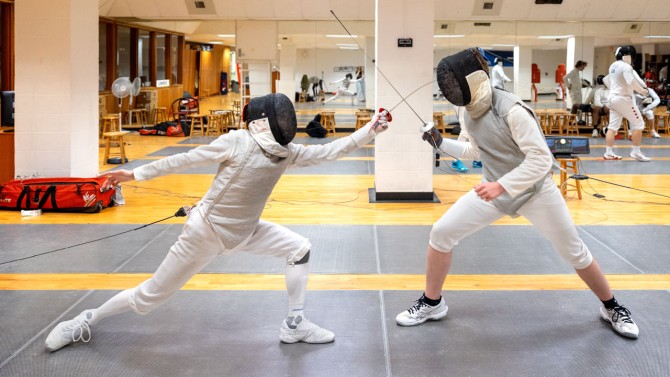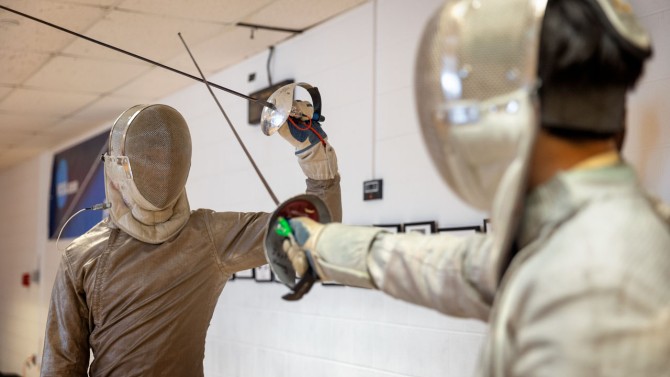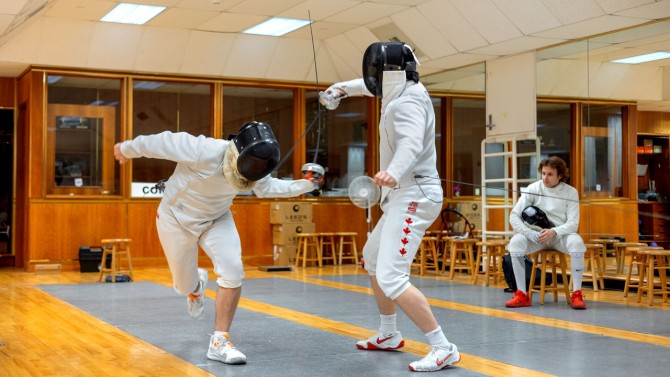Fencers Max Dolmetsch ’25 and Riley Xian ’25 went into the U.S. Association of Collegiate Fencing Clubs championships with modest hopes. If they were lucky, maybe they would clinch the top five in the épée, their weapon of choice and one of three used in fencing.
But then they began winning bout after bout. Dolmetsch beat fencers from the team he’d lost to in 2022; Xian won a nail-biting bout by a single point. Meanwhile teammates in the other weapons were winning as well. In the end, the Cornell Men’s Fencing Club claimed the national title and took silver in both foil and saber and gold in épée, on April 13-14 in Virgina Beach, Virginia.
Students from the Men’s Fencing Club, which clinched a surprise win at the U.S. Association of Collegiate Fencing Clubs championships, spar at a practice on May 1.
The surprise win was all the sweeter for the team’s upperclassmen, who have spent the last three years rebuilding the club after the COVID-19 pandemic shut it down. In 2021-22, the team had very few junior or senior leaders, and Xian and Dolmetsch were frequently the only épéeists, having to forfeit rounds because they lacked a third fencer.
“We’ve really been partners in crime since then,” said Dolmetsch, an applied mathematics major in the College of Arts and Sciences (A&S). “There was a feeling on the team that we were underdogs, but that also motivated us. We’re all here because we love fencing, and we want to win.”
Strength in diversity
The USACFC title is the program’s third since men’s fencing became a club in 1994 – they won in 2004 and again in 2018. The victories are the result of a team culture, reset post-pandemic by captains Xian and Gabriel Montalvo-Zotter ’24, that prizes teamwork, commitment and an embrace of diversity in many forms.
This has been especially important for Dolmetsch, who is autistic and said his autism may make him a better fencer – with his ability to focus and problem solve – but poses difficulties in a team setting; he struggles with social cues and large social gatherings. He said the team has eased his anxieties and supported him, especially Xian, who sends Dolmetsch written reminders and ensures he feels included.
“There’s been a lot of support from the team, a lot of help and general accommodation,” Dolmetsch said.
The team is also diverse geographically and racially – with multiple Asian, Black and Hispanic members, including Lucas Lutar, a fencer for the national Peruvian team and this year’s USACFC champion in foil. Dolmetsch has roots in Colombia, where he hopes to compete for the national team next year. Xian, who is Chinese-Canadian, said the diversity often manifests in a fencer’s style.
“I’m from Canada and trained with a Chinese coach. Other guys train with Russian coaches, American coaches – everyone has their own style,” said Xian, a student in the ILR School.
First-year fencer Langston Johnson ’27 (left) defends with his weapon of choice, the saber, at a practice on May 1.
That diversity of styles and backgrounds – and even the range of sizes of the athletes – also benefits the overall fencing program; a subset of the men’s team serves as a practice squad for the women’s varsity team, giving each group a wider variety of opponents with which to train.
“Some guys can have more brute force – I’m like 6’1″ – and that can be a different kind of challenge for some of the women,” Xian said. “Whereas the women have really refined skills. So we help each other out.”
That teamwork defines the club culture, as well as empathy. Last fall, when an opposing team found ways to combat Dolmetsch’s unique fencing style – he uses the less common French grip on his épée and, as a lefty, holds his weapon wide, limiting his opponents’ ability to strike – Xian saw his frustration. He spent the next month working with Dolmetsch to practice responses to the attacks.
“There’s a real impulse to fence competitively, but he took the time to pause and set it up and give me advice,” said Dolmetsch. “It’s one of the advantages of having a squad, because your teammates can see you and help you.”
“It was funny because, before, I could pretty easily beat him 90% of the time, but after, he started beating me 50% of the time,” said Xian. “But I helped him improve which is good for the team.”
Intense fun
What bonds the club most is their love of the sport – which many of the athletes have been practicing since middle school and which they say engages both mind and body.
Riley Xian ’25 (right), Men’s Fencing Club co-captain, led the épéeists to gold at the U.S. Association of Collegiate Fencing Clubs championships on April 13-14.
“Everything that happens on the strip, you’re responsible for, whether you win or lose, and I think that’s something that really drew me,” said Montalvo-Zotter, a computer science major in the Ann S. Bowers College of Computing and Information Science and A&S. “That along with the tactical aspects, because fencing is very multi-dimensional. There’s a lot of thinking that goes into it.”
Montalvo-Zotter also described the atmosphere at team tournaments, the cheering and the sudden silence once a bout begins. “I’m not even sure how to describe it,” he said. “It’s very intense.”
“It’s stressful but also one of the most fun things you can do,” Dolmetsch said. “And having fun is a really important part of it.”
And while many of the fencers have competed successfully as individuals and have individual ambitions, Xian said the team makes a huge difference.
“The best thing about competing as a team is that you have them behind you,” Xian said. “You feel their power and their support, and it makes you give it your all.”










